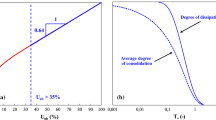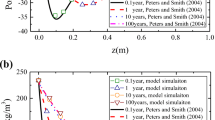Abstract
Consolidation (and swelling) of clayey soils caused by change in chemistry of pore fluid is addressed. Such phenomena are caused by changes in the concentration of various species in the solution and result primarily from a stress-independent deformation of individual clusters, and from a mechanical weakening or strengthening of the clay solid matrix in the presence of stress. Second, transport of chemicals that involves concentration gradients induces additional driving forces of osmotic consolidation due to semipermeable membrane nature of clay. In this paper an extension of Terzaghi's model of the mechanical consolidation to incorporate chemical loading of soil is proposed. A linearized model is used to solve analytically two one-dimensional problems of consolidation of a homogeneous layer simulating a landfill liner with drained or undrained boundaries. The numerical results show a strong dependence of distribution of pore pressure on the chemical load and chemically induced settlements of soil to be comparable to the mechanical ones.
Similar content being viewed by others
References
Barbour, S. L.: 1987, The role of physicochemical effects on the behavior of clay soils, 40th Canadian Geotechnical Conference, Regina, pp. 323–342.
Barbour, S. L. and Fredlund, D. G.: 1989, Mechanisms of osmotic flow and volume change in clay soils, Can. Geotech. J. 26, 551–562.
Biot, M. A.: 1941, General theory of three-dimensional consolidation, J. Appl. Phys. 12, 155–164.
Bolt, G. H.: 1956, Physico-chemical analysis of the compressibility of pure clays, Geotechnique 6(2), 86–93.
Carnahan, C. L. and Jacobsen, J. S.: 1990, Coupled transport processes in semipermeable media. Part I: Theoretical basis, Lawrence Berkeley Laboratory Report, LBL-25618.
Crank, J.: 1956, The Mathematics of Diffusion, Oxford University Press.
Eisenberg, S. R. and Grodzinsky, A. J.: 1987, The kinetics of chemically induced nonequilibrium swelling of articular cartilage and corneal stroma, J. Biomech. Engng. 109, 79–89.
Fernandez, F. and Quigley, R. M.: 1985, Hydraulic conductivity of natural clays permeated with simple liquid hydrocarbons, Can. Geotech. J. 22, 205–214.
Fernandez, F. and Quigley, R. M.: 1988, Viscosity and dielectric constant controls on the hydraulic conductivity of clayey soils permeated with water-soluble organics, Can. Geotech. J. 25, 582–589.
Fernandez, F. and Quigley, R. M.: 1991, Controlling the destructive effects of clay-organic liquid interactions by application of effective stress, Can. Geotech. J. 28, 388–398.
Greenberg, J. A., Mitchell, J. K. and Witherspoon, P. A.: 1973, Coupled salt and water flows in a groundwater basin, J. Geophys. Res. 78, 6341–6353.
Hassanizadeh, S. M.: 1986, Derivation of basic equations of mass transport in porous media. Part I: macroscopic balance laws, Adv. Water Resour. 9, 196–206.
Hueckel, T.: 1992a, Effective stress and deformation in clays subjected to environmental loads: Discussion, Can. Geotech. J. 29(6), 1120–1125.
Hueckel, T.: 1992b, Water-mineral interaction in hygro-mechanics of clays exposed to environmental loads: a mixture approach, Can. Geotech. J. 29, 1071–1086.
Hueckel, T.: 1995, Strain and contamination history dependence in chemo-plasticity of clays subjected to environmental loads, in: G. N. Pande and S. Pietruszczak (eds), Numerical Models in Geomechanics, NUMOG V, Balkema, Rotterdam, pp. 329–336.
Hueckel, T.: 1997, Chemo-plasticity of clays subjected to flow of a single contaminant and stress, Int. J. Numer. Anal. Methods Geomech. 21(1), 43–72.
Hueckel, T., Kaczmarek, M. and Caramuscio, P.: 1997, Theoretical assessment of fabric and permeability changes in clays affected by organic contaminants, Can. Geotech. J. 34(4), 588–603.
Kaczmarek, M. and Hueckel, T.: 1998, A note on the use of porosity in models of consolidation, J. Eng. Mech. 124(1), 237–239.
Katchalsky, A. and Curran, P. F.: 1965, Nonequilibrium Thermodynamics in Biology, Harvard University Press.
Lambe, T. W.: 1960, A mechanistic picture of shear strength in a clay, Conf. Shear Strength Soils, Colorado, pp. 503–532.
Mei, C. C.: 1995, Mathematical Analysis for Engineering, Cambridge University Press.
Mitchell, J. K.: 1962, Components of pore water and their engineering significance, 9th Nat. Conf. Clays and Clay Minerals, pp. 162–184.
Mitchell, J. K.: 1993, Fundamentals of Soil Behavior, Wiley, New York.
Mitchell, J. K., Greenberg, J. A. and Witherspoon, P. A.: 1973, Chemo-osmotic effects in fine-grained soils, ASCE J. Soil Mech. Found. Engng. 99, 307–322.
Morgenstern, N. M. and Balasubramonian, B. I.: 1980, Effects of pore fluid on swelling of clay-shale, Proc. 4th Int. Conf. on Expansive Soils, Denver, Colorado, pp. 190–205.
Myers, T. G., Aldis, G. K. and Naili, S.: 1995, Ion induced deformation of soft tissue, Bull. Math. Biology 57, 77–98.
Sherwood, J. D.: 1994, A model of hindered solute transport in a poroelastic shale, Proc. R. Soc. London A 445, 679–692.
Skipper, N. T., Refson, K. and McConnel, J. D. C.: 1991, Computer simulation of interlayer water in 2:1 clays, J. Chem. Phys. 94, 7434–7445.
Sridharan, A. and Venkatappa Rao, G.: 1973, Mechanisms controlling volume change of saturated clays and the role of the effective stress concept, Geotechnique 23(3), 359–382.
Terzaghi, K.: 1923, Die Berechnung der Durchlassingkeitsziffer des Tones aus dem Verlauf der hydrodynamischen Spannungserscheinungen, Akad. Wissen. Wien, Sitzungsberichte Math. Naturwiss. 132, 125–138.
Terzaghi, K.: 1943, Theoretical Soil Mechanics, Chapman and Hall.
Torr, H. L.: 1964, Solution of the linearized equations of multicomponent mass transfer, A.I.Ch.E. J. 10, 448–466.
Yeung, A. T., Mitchell, J. K.: 1993, Coupled fluid, electrical and chemical flows in soils, Geotechnique 43, 121–134.
Young, A. and Low, P. F.: 1965, Osmosis in argillaceous rocks, Bull. Am. Assoc. Petrol. Geol. 49, 1004–1008.
Author information
Authors and Affiliations
Rights and permissions
About this article
Cite this article
Kaczmarek, M., Hueckel, T. Chemo-Mechanical Consolidation of Clays: Analytical Solutions for a Linearized One-Dimensional Problem. Transport in Porous Media 32, 49–74 (1998). https://doi.org/10.1023/A:1006530405361
Issue Date:
DOI: https://doi.org/10.1023/A:1006530405361




